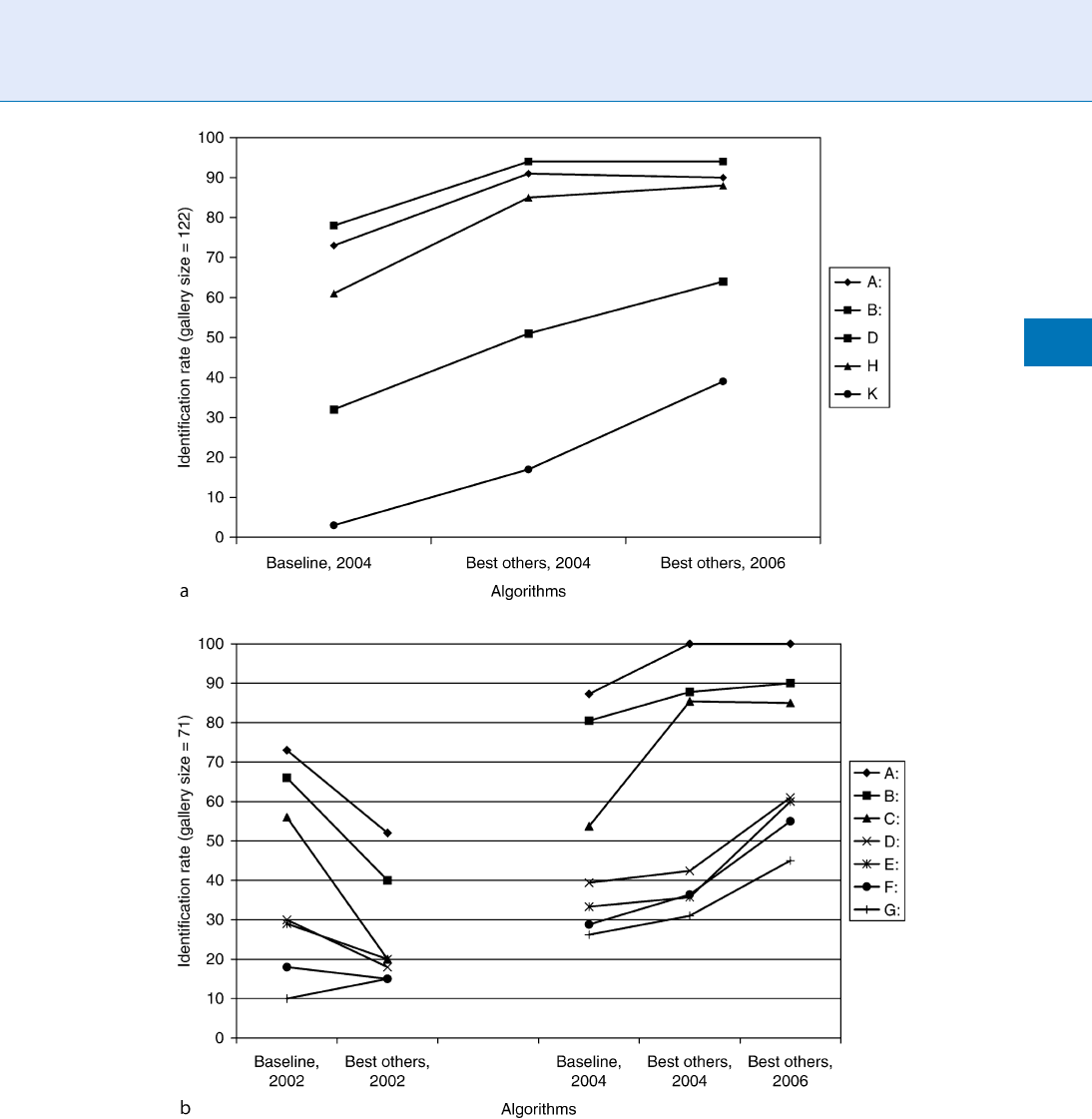Li S.Z., Jain A.K. (eds.) Encyclopedia of Biometrics
Подождите немного. Документ загружается.


enrollment, and matching failures. However, further
understanding in the area of biometric system ergo-
nomic design and its impact on biometrics is needed
to meet this goal.
The authors are not alone in their thoughts
and opinions that continued research is needed in
the area of biometric system ergonomic design. As
Smith [11] stated that some members of the HCI
community believe that interfaces of security systems
do not reflect good thinking in terms of creating a
system that is easy to use, while maintaining an accept-
able level of security. Moreover Adams and Sasse dis-
cussed the fact that security systems are one of the last
areas to embrace user-centered design and training
as essential [12]. Lastly, Maple and Norrington [20],
noted three observations that align with the objective
for continued investigation in biometric system ergo-
nomic design:
People have different cognitive abilities,
People have different physical characteristics and
interact differently with equipment, and
People have different sensory abilities and will per-
ceive biometric sensors and systems differently.
As the biometrics community continues to develop
biometric systems and deployments become more per-
vasive, the evaluation of the biometric system and the
respective human-biometric sensor interaction w ill
continue to gain traction.
Related Entries
▶ Accessibility
▶ Attempt
▶ Failure to Acquire (FTA)
▶ Failure to Enroll (FTE)
▶ Usuability
References
1. International standards organization, information technology –
Biometric performance testing and reporting – Part 1: Principles
and framework. ISO/IEC: Geneva. p. 56. (2006)
2. International standards organization, information technology –
Biometric performance testing and reporting - Part 2: Testing
methodologies for technology and scenario evaluation. ISO/IEC:
Geneva. p. 48. (2007)
3. International standards organization, Text of DTR 19795-3,
Biometric performance testing and reporting – Part 3:
Modality-specific testing. ISO/IEC: Geneva. p. 28. (2007)
4. Clarke, R.: Human identification in information systems: Man-
agement challenges and public policy issues. Inf. Technol. People
7(4), 6–37 (1994)
5. Young, M., Elliott, S.: Image Quality and Performance Based on
Henry Classification and Finger Location. In IEEE Workshop on
Automatic Identification Advanced Technologies. Alghero, Italy
(2007)
6. Wayman, J.: Multi-finger penetration rate and ROC variability
for automatic fingerprint identification systems. In: Wayman, J.
(ed.) National Biometric Test Center Collected Works
1997–2000, pp. 179–190. San Jose, CA (2000)
7. Kukula, E.: Design and Evaluation of the Human-Bio-
metric Sensor Interaction Method. In: Industrial Tech-
nology, Vol. 1, Ph.D, pp. 510. Purdue University: West
Lafayette (2008)
8. Kukula, E., Elliott, S., Duffy, V.: The effects of human interaction
on biometric system performance in 12th International Confer-
ence on Human-Computer Interaction and 1st International
Conference on Digital-Human Modeling. pp. 903–913, Springer,
Beijing, China (2007)
9. Yao, M., Pankanti, S., Haas, N.: Fingerprint quality assessment.
In: Ratha, N., Bolle, R. (eds.) Automatic Fingerprint Recognition
Systems, pp. 55–66. Springer, New York (2004)
10. Rubin, R.: Handbook of usability testing: How to plan, design,
and conduct effective tests. Wiley, New York (1994)
11. Smith, S.: Humans in the loop: Human-computer interaction
and security. IEEE Secur. Priv. 1(3), 75–79 (2003)
12. Adams, A., Sasse, M.: Users are not the enemy : Why users
compromise security mechanisms and how to take remedial
measures. Commun. ACM 42(12), 41–46 (1999)
13. Coventry, L., De Angeli, A., Johnson, G.: Usability and biometric
verification at the ATM interface. In: Conference on Human
Factors in Computing Systems. Ft. Lauderdale, ACM Press,
Florida (2003)
14. Tayyari, F., Smith, J.: Occupational ergonomics: Principles and
applications. In: Parsaei, H. (ed.) Manufacturing Systems Engi-
neering Series, p. 452. Kluwer Academic Publishers, Norwell
(2003)
15. International organization for standardization, ISO 9241: Ergo-
nomic requirements for office work with visual display terminals
(VDTs) - Part 11: Guidance on usability. p. 28. (1998)
16. Coventry, L.: Usable biometrics. In: Cranor, L.F., Garfinkel, S.
(eds.) Security and usability: Designing secure systems that
people can use, pp. 175–198. O’Reilly Media, Inc: Sebastopol,
CA (2005)
17. NIST. Biometrics and usability group. Available from: http://
zing.ncsl.nist.gov/biousa/index.html (2007). Accessed 30
November 2007
18. Purdue University Biometric Standards Performance & Assur-
ance Laboratory. Human Biometric Sensor Interaction. 2007
[cited 2007 November 30]; Available from: http://www.bspa
labs.org/archives/category/research/hbsi
19. Home office identity & passport service. Publications. Available
from: http://www.ips.gov.uk/passport/publications-general.asp
(2007). Accessed 30 November 2007
20. Maple, C., Norrington, P.: The usability and practicality of
biometric authentication in the workplace. In: First Interna-
tional Conference on Availability, Reliability and Security
(ARES’06). IEEE, Vienna, Austria (2006)
280
E
Ergonomic Design for Biometric Systems

Ergonomics
Ergonomics is a derivative of the Greek words ‘‘ergon,’’
or work, and ‘‘nomos,’’ meaning laws. While the term
work has been traditionally associated with occupation,
a broader sense of the term can be applied to any
unplanned activity requiring skill or effort. In 2000,
the International Ergonomics Association (IEA) de-
fined ergonomics or human factors as: ‘‘The scientific
discipline concerned with the understanding of inter-
actions among humans and other elements of a system,
and the profession that applies theory, principles, data
and methods to design in order to optimize human
well-being and overall system performance.’’ In design,
ergonomics attempts to achieve an optimal relation-
ship between humans and machines in a particular
environment. The goal of ergonomics, according to
Tayyari and Smith, is to ‘‘fit (adapt) work to indivi-
duals, as opposed to fitting individuals to the work.’’
▶ Ergonomic Design for Biometric System
Error Probability Non-Accumulation
▶ Score Normalization Rules in Iris Recognition
Evaluation of Gait Recognition
SUDEEP SARKAR
1
,ZONGYI LIU
2
1
Computer Science and Engineering, University of
South Florida, Tampa, FL, USA
2
Amazon.com, Seattle, WA, USA
Synonyms
Gait recognition
Definition
Gait recognition refers to automated vision methods
that use video of human gait to recognize or to identify
a person. Evaluation of gait recognition refers to the
benchmarking of progress in the desig n of gait recog-
nition algorithms on standard, common, datasets.
Introduction
Design of biometric algorithms and evaluation of
performance goes hand in hand. It is important to
constantly evaluate and analyze progress being at vari-
ous levels of biometrics design. This evaluation can
be of three types: at algorithm-level, at scenario-level,
and at operational-level, roughly corresponding to the
maturity of the biometric. Given the young nature
of gait as a biometric source, relative to the mature
biometrics such as fingerprints, current evaluations are
necessarily at algorithm-level. The motivation behind
algorithm-level evaluations is to explore possibilities,
to understand limitations, and to push algorithmic re-
search towards hard problems. Some of the relevant
questions are
1. Is progress being made in gait recognition of
humans?
2. To what extent does gait offer potential as an iden-
tifying biometric?
3. What factors affect gait recognition and to what
extent?
4. What are the critical vision components affecting
gait recognition from video?
5. What are the strengths and weaknesses of different
gait recognition algorithms?
An overview of the current evaluation of gait as a
potential biometric is discussed here, with particular
emphasis on the progress with respect to the HumanID
gait challenge problem that has become the de-facto
benchmark. A synthesis of gait recognition perfor-
mances reported on this dataset and other major
ones is provided here, along with some suggestions
for future evaluations.
A Panoramic View of Performance
To take stock of the progress made in gait recognition,
consider a summary of the identification rates reported
in the recent literature on different kinds of publicly
available experimental protocols and datasets (>25
persons) such as the CMU-Mobo dataset [1] (indoor,
Evaluation of Gait Recognition
E
281
E

25 subjects), the UMD dataset [2] (outdoor, 55 sub-
jects), the Southampton Large dataset [3] (indoor and
outdoor, 115 subjects), the CASIA Gait Dataset [4]
(indoor, 124 subjects), and the HumanID Gait Chal-
lenge dataset [5] (outdoor, 122 subjects). Figure 1 lists
the average identification rates for matching across
different conditions, i.e., the
▶ probe and the gallery
differed with respect to the indicated
▶ covariate.Of
course, the caveat is that the conclusions are conditioned
on the kinds of variations of each covariate observed in
the respective datasets. Hence, a definitive conclusion
is hard to make. However, this kind of summary has
some conclusive weight since, it encompasses the find-
ings of multiple research groups. It should provide
some directions for focusing future research. The
data shows that outdoor gait recognition, recognition
across walking surface-type change, and recognition
across months are all hard problems. Clothing, foot-
wear, carrying condition, and walking speed does not
seem to be hard covariates to overcome. As expected,
performance also drops with dataset size, which sug-
gests that it is imperative to demonstrate the efficacy of
an idea on as large a dataset as possible.
A deeper look at the performances reported
on commonly available datasets, in particular the
HumanID gait challenge problem, will form the basis
for more definitive conclusions about the progress that
is being made.
The HumanID Gait Challenge Problem
The development of gait biometrics is following a path
that is somewhat different from other biometrics, for
which serious evaluation benchmarks appeared after
years of algorithmic development. It was more than
20 years for face recognition, whereas evaluation
framework for gait recognition appeared in less than
10 years after the first publication of vision algorithms
for gait recognition. Bulk of the research in gait recog-
nition was spurred by the DARPA HumanID at a
distance program. The HumanID gait challenge prob-
lem was formulated in this program to facilitate objec-
tive, quantitative measurement of gait research
progress on a large dataset [5]. As of end of 2007, this
dataset has been distributed to more than 40 research
groups. Many gait recognition research papers report
performance on this dataset.
This challenge problem does not just consist of a
dataset, but also provides a well-defined experimental
Evaluation of Gait Recognition. Figure 1 Summary (average) of gait identification rates as reported in the literature
for different conditions. The average of the reported rates are listed for different conditions. The first two performance
points are average of reported rates on datasets collected indoors and outdoors, respectively. The next six performance
points are for matching gait templates across different conditions. For example, ‘‘carrying condition’’ refers to matching
gait sequences where the hands of the subjects were free to sequences where the subjects were carrying a briefcase. The
‘‘time’’ condition refers to matching gait templates collected at different times with the time-gap as noted. The size
condition refers to number of subjects used in the experiments.
282
E
Evaluation of Gait Recognition

framework for others to follow, along with an estab-
lished benchmark.
The Dataset
The data was collected outdoors. For each person in
the data set, there are combination of as many as five
conditions or covariates. The conditions are: (1) two
camera angles (L and R), (2) two shoe types (A and B),
(3) two surfaces (grass and concrete), (4) with and
without carrying a briefcase (B or NB), and (5) two
different dates 6 months apar t, May and November.
The covariates were chosen based on consultation with
gait recognition researchers in the Human ID program.
These are, of course, not the only variables that
can impact gait , but were logistically feasible and likely
to impact gait the most. Attempt was made to acquire a
person’s gait in all possible combinations, and there are
up to 32 sequences for some persons. Hence, the full
dataset can be partitioned into 32 subsets, one for each
combination of the five covariates. The partitioning of
the data is visualized in Fig. 2. Each cell refers to an
unique combination of view, shoe type, and surface
covariates. The smaller arrangement of cells represent
the data from repeat subjects. Comparisons between
these subsets are used to set up challenge experiments;
more on this later. The full data set consists of 1,870
sequences from 122 individuals. This dataset is unique
in the number of covariates exercised. It is the only
data set to include walking on a grass surface. Figure 3
shows some sample frames from this dataset.
In addition to the raw data sequence, there is an
ancillary information associated with the data. First, for
each sequence, there is meta-data information about the
subject’s age, sex, reported height, self reported weight,
foot dominance, and shoe information.
Second, for a subset of this dataset, manually created
▶ silhouettes (see Fig . 4) are available. These manual
silhouettes should not be used to test any recogni-
tion algorithm, but they could be used to build models
or to study segmentation errors. More details about
the process of creating these manual silhouettes
and the quality checks performed can be found in
[6]; here are some salient aspects. Seventy one subjects
from one of the two collection periods (May collection)
were chosen for manual silhouette specification. The
sequences corr esponding to these subjects were chosen
from the (1) gallery set (sequences tak en on grass, with
shoe type A, right camera view), (2) probe B (on grass,
with shoe type B, right camera view), (3) probe D (on
concrete, with shoe type A, right camera view), (4) probe
H (on grass, with shoe A, right camera view, carry-
ing briefcase), and probe K (on grass, elapsed time).
The silhouette in each frame over one walking cycle,
of approximately 30–40 image frames was manually
Evaluation of Gait Recognition. Figure 2 Partitioning of the HumanID gait challenge dataset in terms of its
covariates, which are coded as follows: C – concrete surface, G – grass surface, A – first shoe type, B – second shoe type,
BF–carryingabriefcase, NB–nobriefcase, M–datacollectedinMay,N
1
– new subjects in November data, and N
2
– repeat
subjects in November. The shaded cells are used to design the challenge experiments.
Evaluation of Gait Recognition
E
283
E

specified. This cycle was chosen to begin at the right heel
strike phase of the walking cycle through to the next
right heel strike. Whenever possible, this gait cycle was
selected from the same 3D location in each sequence. In
addition to marking a pixel as being from the back-
ground or subject, more detailed specifications in
terms of body parts were mark ed. The head, torso, left
arm, right arm, left upper leg, left lower leg, right upper
leg, and right lower leg were explicitly labeled using
different colors.
The Challenge Experiments
Along with the dataset, the gait challenge problem
includes a definition of 12 challenge experiments (A–L),
spanning different levels of difficulty. This provides a
common benchmark to compare performance with
other algorithms. The experiments are designed to
investigate the effect on performance of five factors,
i.e., change in viewing angle, change in shoe type,
change in walking surfaces (concrete and grass),
Evaluation of Gait Recognition. Figure 3 Frames from (a) the left camera for concrete surface, (b) the right camera for
concrete surface, (c) the left camera for grass surface, (d) the right camera for grass surface.
Evaluation of Gait Recognition. Figure 4 Top row shows the color images, cropped around the person, for one
sequence. The bottom row shows the corresponding part-level, manually specified silhouettes.
284
E
Evaluation of Gait Recognition

carrying or not carrying a briefcase, and temporal
differences. The gallery set is common for all the
experiments and corresponds to the dark colored cell
in Fig. 2. The gallery consists of sequences with the
following covariates: Grass, Shoe Type A, Right Cam -
era, No Briefcase, and collected in May along with
those from the new subjects from November. This set
was selected as the gallery because it was one of the
largest for a given set of covariates. The experiments
differ in terms of the probe sets, which are denoted by
the lightly shaded cells. The structure of the 12 probe
sets is listed in Table 1. The signatures are the video
sequences of gait. The last two experiments study the
impact of elapsed time. The elapsed time covariate
implicitly includes a change of shoe and clothing
because the subjects were not required to wear the
same clothes or shoes in both data collections. Because
of the implicit change of shoe, it can be safely assumed
that a different set of shoes were used in the May and
November data collections. This is noted in Table 1 by
A/B for shoe type in experi ments K and L. The key
experiments are those that involve controlled change in
just one covariate and are marked with an asterisk in
the table. The results from the 12 experiments provide
an ordering of difficulty of the experiments.
Baseline Gait Algorithm
The third aspect of the gait challenge problem is a
simple but effective
▶ baseline algorithm to provide
performance benchmarks for the experiments. Ideally,
this should be a combination of ‘‘standard’’ vision mod-
ules that accomplishes the task. Drawing from the suc-
cess of template based recognition strategies in
computer vision, a four-part algorithm that relies on
silhouette template matching was designed. The first
part semi-automatically defines bounding boxes around
the moving person in each frame of a sequence. The
second part extracts silhouettes from the bounding
boxes using expectation maximization based on Maha-
lanobis distance between foreground and background
color model at each pixel. Each silhouette is scaled to a
height of 128 pixels and centered (automatically) in
each frame along the horizontal direction so that the
centerline of the torso is at the middle of the frame.
Evaluation of Gait Recognition. Table 1 The gallery and probe set specifications for each of gait challenge experiments
Probe
Exp.
(surface, shoe, view, carry, elapsed
time) (C/G, A/B, L/R, NB/BF, time) Number of subjects Difference
A
a
(G, A, L, NB, M + N
1
) 122 V
b
B
a
(G, B, R, NB, M + N
1
)54S
c
C (G, B, L, NB, M + N
1
) 54 S+V
D
a
(C, A, R, NB, M + N
1
) 121 F
d
E (C, B, R, NB, M + N
1
) 60 F+S
F (C, A, L, NB, M + N
1
) 121 F+V
G (C, B, L, NB, M + N
1
) 60 F+S+V
H
a
(G, A, R, BF, M + N
1
) 120 B
e
I (G, B, R, BF, M + N
1
) 60 S+B
J (G, A, L, BF, M + N
1
) 120 V+B
K
a
(G, A/B, R, NB, N
2
)33T
f
+S+C
g
L (C, A/B, R, NB, N
2
) 33 F+T+S+C
The gallery for all of the experiments is (G, A, R, NB, M +N
1
) and consists of 122 individuals
a
Keyexperiments
b
View
c
Shoe
d
Surface
e
Carry
f
Elapsed time
g
Clothing
Evaluation of Gait Recognition
E
285
E

The third part computes the gait period from the sil-
houettes. The gait period is used to partition the
sequences for spatial-temporal correlation. The fourth
part performs spatial-temporal correlation to compute
the similarity between two gait sequences.
Let S
P
¼fS
P
ð1Þ; ; S
P
ðMÞgand S
G
¼fS
G
ð1Þ;
; S
G
ðNÞg, be the probe and the gallery silhouette
sequences, respectively. First, the probe (input) se-
quence is partitioned into subsequences, each roughly
over one gait period, N
Gait
. Gait periodicity is esti-
mated based on periodic variation of the count the
number of foreground pixels in the lower part of the
silhouette in each frame over time. This number will
reach a max imum when the two legs are farthest apart
(full stride stance) and drop to a minimum when the
legs overlap (heels together stance).
Second, each of these probe subsequences, S
Pk
¼
fS
P
ðkÞ; ; S
P
ðk þ N
Gait
Þg, is cross correlated with the
given gallery sequence, S
G
.
CorrðS
Pk
; S
G
ÞðlÞ¼
X
N
Gait
j¼1
S S
P
ðk þ jÞ; S
G
ðl þ jÞðÞ; ð1Þ
where, the similarity between two image frames,
S(S
P
(i), S
G
(j)), is defined to be the Tanimoto similarity
between the silhouettes, i.e., the ratio of the number of
common pixels to the number of pixels in their uni on.
The overall similarity measure is chosen to be the
median value of the maximum correlation of the gal-
lery sequence with each of these probe subsequences.
The strategy for breaking up the probe sequence into
subsequences allows the algorithm to overcome seg-
mentation errors in some contiguous sets of frames
due to some background subtraction artifact or due to
localized motion in the background.
SimðS
P
; S
G
Þ¼Median
k
max
l
CorrðS
Pk
; S
G
ÞðlÞ
: ð2Þ
The baseline algorithm is parameter free. The algo-
rithm, although straightforward, performs quite well
on some of the experiments and is quite competitive
with the first generation of gait recognition algorithms.
Performance on the Gait Challenge
Problem
The results reported for the Gait Challenge problem
are of two types, ones that report results on the
first version of the dataset that was released with 71
subjects and the second set of results are those reported
for the full dataset with 122 subjects. The smaller
dataset allows just the first eight experiments listed in
Table 1, but with reduced gallery set sizes. Figure 5a
tracks the baseline performance and the best perfor-
mance reported in the literature. As of middle of 2007 ,
there were 18 papers that reported results on the smal-
ler version of the problem. In 2002, when the Gait
Challenge Problem was released, the performance of
the baseline algorithm was better than the best reported
performance. By 2004, whi le the baseline algorithm
performance improved as the algorithm was fine-
tuned, the performance of the best performance im-
proved significantly and continued to improve through
2006. This trend is also seen in the results reported in
six papers on the full dataset, summarized in Fig. 5b.
As is evident, the gait challenge problem has al-
ready spurred the development of gait recognition
algorithms with improving performanc e. What is partic-
ularly interesting to notice is that the performance
on har d experiments such those across surfac e (experi-
ment D) and elapsed time (experiment K) has improved.
Of course, there is still room for further impro vement.
Another interesting aspect is that the improvement of
performance from 2004 to 2006 was not due to
‘‘ c ontinue d engineering’’ of existing approaches, but
inv olv ed the redesign of the recognition appr oaches.
For instanc e, the greatest gains came from appr oaches
that analyzed the silhouette shapes rather than the dy-
namics [2, 7]. Dynamics is important, but by itself is
not sufficient.
Performance of a large number of algorithmic
approaches have been explored. A review of the per-
formances reported in these works reveals* [8] that
1. All most all of these approaches are based on
silhouettes.
2. There is no one method that performs the best on
all experiments.
3. Performances that involve matching against view-
point and shoe variations, but on the same walking
surface, has plateaued out.
4. Matching against walking surface variation remains
a challenge.
5. Good performances (>80%) has been reported for
matching w ith and without carrying objects.
6. Matching across 6 months time difference has low
performance, but the number of subjects involved
in this experiment (33 subjects) is too low to derive
meaningful conclusions.
286
E
Evaluation of Gait Recognition

Other Large Datasets
There are currently two other datasets that are as large as
the H umanID gait challenge dataset in terms of number
of subjects. First is the CASIA Indoor Gait Database [4].
The gallery set includes 124 subjects with normal walk-
ing, no coat and no carr y bag. Different probes can be
defined in terms of changes in (1) viewpoint, (2) cloth-
ing change (coat vs. no-coat), and (3) carrying a bag
and not carrying a bag. Not many algorithms have
Evaluation of Gait Recognition. Figure 5 Improvement in gait recognition algorithms over time with respect to the
baseline performance. (a) Results on the first release of the gait dataset with 71 subjects in the gallery for the first eight
experiments listed in Table 1 are tracked here. (b) Results on the full dataset with 122 subjects for the key experiments
listed in Table 1. From 2004 to 2006, the best reported performances are better on all the experiments.
Evaluation of Gait Recognition
E
287
E

reported performance on this dataset yet. But, the
performance reported for the gait energy image ap-
proach in [9], seems to corroborate the findings from
the HumanID Problem for matching across carrying
conditions: a performance of upto 80% is reported for
the CASIA dataset.
The other large dataset is the SOTON HID Gait
Database [10] with 115 subjects are collected mostly
indoor and some under outdoor conditions. The in-
door SOTON datase t was collected to examine the
premise that gait is unique so the background is
controlled so as to allow easy segmentation. The
same subjects were also filmed walking outdoors
to determine whether gait biometrics could be per-
ceived with complex backgrounds. Performances in
the range of 72–85% have been reported for matching
across sessions using a variety of approaches. This
dataset also affords the matching across time issue. It
has been shown that a time-dependent predictive
model [11 ] results in 92% recognition, but only for
ten subjects.
It is worth noting that face recognition on
these data sets would be poor, indeed given the low-
resolution and the uncontrolled lighting.
Future Evaluations
It is to be expected that each gait research group
would collect their own data set to develop ideas.
This is an important process. For instance, one new
dataset is the CASIA infrared night gait dataset [12].
It consists of gait data from 153 subjects are collected
outdoors, at night, with and without carrying condi-
tion, and at two different speeds. This dataset nicely
complements existing datasets that are collected dur-
ing the day. Given the data-driven nature of bio-
metrics research, the key to future progress are such
data sets, collected to explore issues not considered or
raised by existing ones. For instance, as of today there
is need for the better understanding of the variation
of gait due to surface conditions and across elapsed
time. Also, currently there is no dataset to explore the
matching across time issue for a large number of
subjects.
Ideally, the new datasets should consist of gait data
from around 1,000 subjects, an order of magnitude
larger than current large datasets. It is important to
increase the number of subjects so, that it is possible to
empirically study the scaling of perf ormance with
number of subjects. Some guidance about the requi-
red sizes can be found in [13, 14], where statistical
reasoning is employed to relate the number of subjects
with target error confidences. The data collection
should include gait data repeated at regular time inter-
vals of weeks, spanning about a year. The datase t
should be collected in outdoor conditions, preferably
collected at a distance of 300 m to reflect real
world conditions. The dataset should come with a set
of well defined experiments in terms of gallery
and probe sets. These experiments will influence the
types of algorithms. For the experiments to be effective
at influencing the direction of gait research the design
of the experiments needs to solve the three bears prob-
lem; the experiments must be neither too hard nor
too easy, but just right. If performance on the experi-
ments is easily saturated, then the gait recognition
community will not be challenged. If experiments are
too hard, then it will not be possible to make progress
on gait recognition. Ideally, the set of experiments
should vary in difficulty, characterize where the gait
recognition problem is solvable, and explore the fac-
tors that affect performance. A set of experiments
cannot meet this ideal unless the appropriate set
of data is collected. It is important to view biometrics
research as a data-driven algorithm development
process rather than algorithm-driven data collection
process.
Related Entries
▶ Hidden Markov Models
▶ Human Detection and Tracking
▶ Human Movement, Psychology
▶ Performance Evaluation, Overview
▶ Performance Testing Methodology Standardization
▶ Psychology of Gait Recognition
▶ Silhouette-B ased Gait and Action Recognition
▶ Verification/Authentication/Identification/
Recognition
References
1. Gross, R., Shi, J.: The CMU motion of body (MoBo) database.
Tech. report CMU-RI-TR-01-18, Robotics Institute, Carnegie
Mellon University (2001)
288
E
Evaluation of Gait Recognition

2. Kale, A., Sundaresan, A., Rajagopalan, A.N., Cuntoor, N.P.,
Roy-Chowdhury, A.K., Kru
¨
ger, V., Chellappa, R.: Identifi-
cation of humans using gait. IEEE Transactions on Image Pro-
cessing 13(9), 1163–1173 (2004)
3. Wagg, D.K., Nixon, M.S.: On automated model-based extraction
and analysis of gait. In: International Conference on Automatic
Face and Gesture Recognition, pp. 11–16 (2004)
4. Yu, S., Tan, D., Tan, T.: A framework for evaluating the effect of
view angle, clothing and carrying condition on gait recognition.
In: International Conference on Pattern Recognition, vol. 4,
pp. 441–444 (2006)
5. Sarkar, S., Jonathon Phillips, P., Liu, Z., Robledo-Vega, I.,
Grother, P., Bowyer, K.W.: The Human ID gait challenge prob-
lem: Data sets, performance, and analysis. IEEE Transactions on
Pattern Analysis and Machine Intelligence 27(2), 162–177
(2005)
6. Liu, Z., Malave, L., Osuntogun, A., Sudhakar, P., Sarkar, S.:
Toward understanding the limits of gait recognition. In: Proc.
of SPIE Defense and Security Symposium: Biometric Tech-
nology for Human Identification, pp. 195–205 (2004)
7. Liu, Z., Sarkar, S.: Improved Gait Recognition by Gait Dynamics
Normalization. IEEE Transactions on Pattern Analysis and Ma-
chine Intelligence 28(6), 863–876 (2006)
8. Sarkar, S., Liu, Z.: Handbook of Biometrics, chap. Gait Recogni-
tion. Springer (2008)
9. Han, J., Bhanu, B.: Statistical feature fusion for gait-based
human recognition. In: IEEE Conference on Computer Vision
and Pattern Recognition, vol. II, pp. 842–847 (2004)
10. Shutler, J.D., Grant, M.G., Nixon, M.S., Carter, J.N.: On a
large sequence-based human gait database. In: International
Conference on Recent Advances in Soft Computing, pp. 66–71
(2002)
11. Veres, G., Nixon, M., Carter, J.: Model-based approaches for
predicting gait changes over time. In: International Conference
on Intelligent Sensors, Sensor Networks and Information,
pp. 325–330 (2005)
12. Tan, D., Huang, K., Yu, S., Tan, T.: Efficient night gait recogni-
tion based on template matching. In: International Conference
on Pattern Recognition, vol. 3, pp. 1000–1003 (2006)
13. Doddington, G., Przybocki, M., Martin, A., Reynolds, D.: The
NIST speaker recognition evaluation–Overview, methodology,
systems, results, perspective. Speech Communication 31(2–3),
225–254 (2000)
14. Veres, G., Nixon, M., Carter, J.: Is Enough Enough?? What Is
Sufficiency in Biometric Data?. Lecture Notes in Computer
Science 4142, 262 (2006)
Expected Performance or Utility of
Fingerprint Image in an Automated
Comparison Environment
▶ Fingerprint Image Quality
Expression
Face recognition processing usually requires a neutral
facial expression (no smiling, mouth closed) and with
the subject looking straight at the camera.
▶ Photography for Face Image Data
Extended Enterprise
Beyond the physical boundaries or ‘‘four walls’’ of an
organization is extended enterprise.
▶ Remote Authentication
External Identification
Identification of a victim based on external evidence,
such as the victim’s gender, height, build, face, and
fingerprints.
▶ Dental Biometrics
External Operation Time
▶ Operational Times
Extra-Class
Extra-class refers to instances of different subjects.
Ideally, the extracted features should be very different
for instances of different subjects.
▶ Local Image Filters
Extra-Class
E
289
E
